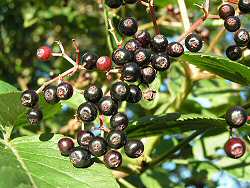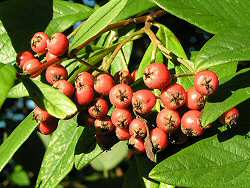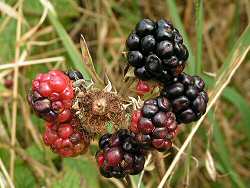| Features: Wildlife Trust Articles |  |
Autumn harvest Elder berries (Sambacus nigra): a great favourite of the birds, particularly blackbirds.
Most gardens include an area of lawn and/or low borders enclosed either by hedges or by walls and fences which are often concealed behind shrubs. Of all our natural habitats, Elder berries (Sambacus nigra): a great favourite of the birds, particularly blackbirds.
Most gardens include an area of lawn and/or low borders enclosed either by hedges or by walls and fences which are often concealed behind shrubs. Of all our natural habitats,  the structure of this arrangement most closely resembles the woodland edge and hedgerow and the wild animals that are attracted to gardens are also those that we find in these habitats the structure of this arrangement most closely resembles the woodland edge and hedgerow and the wild animals that are attracted to gardens are also those that we find in these habitats the structure of this arrangement most closely resembles the woodland edge and hedgerow and the wild animals that are attracted to gardens are also those that we find in these habitats. It makes sense for the wildlife gardener to take full advantage of this relationship by enhancing the qualities which make the woodland edge and hedgerow so attractive to wildlife: one of the best ways of doing this is by ensuring that we plant the most advantageous trees and shrubs in our gardens. the structure of this arrangement most closely resembles the woodland edge and hedgerow and the wild animals that are attracted to gardens are also those that we find in these habitats. It makes sense for the wildlife gardener to take full advantage of this relationship by enhancing the qualities which make the woodland edge and hedgerow so attractive to wildlife: one of the best ways of doing this is by ensuring that we plant the most advantageous trees and shrubs in our gardens.
A succession of harvests
Garden trees and shrubs are important to wildlife at a number of levels: they can provide shelter, breeding places, food and cover under which animals can safely move around the garden. Even when we just consider their value as a food source, we can see that they provide for animals in many different ways: the leaves, especially of native species, are important food for many insects like moth caterpillars;
 There is a place for non-native shrubs in the garden, especially when they are good fruit producers like this Himalyan tree cotoneaster (Cotoneaster frigidus).
likewise nectar and pollen from the flowers are hugely important for butterflies, hoverflies and other insects; and finally There is a place for non-native shrubs in the garden, especially when they are good fruit producers like this Himalyan tree cotoneaster (Cotoneaster frigidus).
likewise nectar and pollen from the flowers are hugely important for butterflies, hoverflies and other insects; and finally  when most other food sources are dwindling, their fruits, nuts and berries provide vital sustenance for animals fighting to survive the most extreme conditions of winter when most other food sources are dwindling, their fruits, nuts and berries provide vital sustenance for animals fighting to survive the most extreme conditions of winter when most other food sources are dwindling, their fruits, nuts and berries provide vital sustenance for animals fighting to survive the most extreme conditions of winter. when most other food sources are dwindling, their fruits, nuts and berries provide vital sustenance for animals fighting to survive the most extreme conditions of winter.
It is this vital wintertime role which is at the forefront of our minds at this time of year. When you first consider (or re-examine) the range of species to include in your garden, you should think about the fruiting periods. Your garden will be most useful if it provides a succession of harvests throughout the winter. For example  rowan berries are some of the earliest to ripen (in my garden they are eaten by the blackbirds before October) whilst the berries of ivy will not ripen until the new year (providing essential late winter food) rowan berries are some of the earliest to ripen (in my garden they are eaten by the blackbirds before October) whilst the berries of ivy will not ripen until the new year (providing essential late winter food) rowan berries are some of the earliest to ripen (in my garden they are eaten by the blackbirds before October) whilst the berries of ivy will not ripen until the new year (providing essential late winter food). In between these two extremes the wildlife will benefit from a range of different trees and shrubs, all producing their harvests at different times. In practical terms this means that you should try to include as great a variety as possible in your garden. rowan berries are some of the earliest to ripen (in my garden they are eaten by the blackbirds before October) whilst the berries of ivy will not ripen until the new year (providing essential late winter food). In between these two extremes the wildlife will benefit from a range of different trees and shrubs, all producing their harvests at different times. In practical terms this means that you should try to include as great a variety as possible in your garden.
 Great fruit producing species include: rowan, bird cherry, wild cherry, hip-bearing roses, elderberry, pyracantha (fire thorn), hawthorn, blackthorn, cotoneaster, alder buckthorn, holly, guelder rose, spindle, whitebeam and wild service tree Great fruit producing species include: rowan, bird cherry, wild cherry, hip-bearing roses, elderberry, pyracantha (fire thorn), hawthorn, blackthorn, cotoneaster, alder buckthorn, holly, guelder rose, spindle, whitebeam and wild service tree Great fruit producing species include: rowan, bird cherry, wild cherry, hip-bearing roses, elderberry, pyracantha (fire thorn), hawthorn, blackthorn, cotoneaster, alder buckthorn, holly, guelder rose, spindle, whitebeam and wild service tree. A good selection of these will provide for your garden wildlife all winter. If you have a moderately large garden, including Great fruit producing species include: rowan, bird cherry, wild cherry, hip-bearing roses, elderberry, pyracantha (fire thorn), hawthorn, blackthorn, cotoneaster, alder buckthorn, holly, guelder rose, spindle, whitebeam and wild service tree. A good selection of these will provide for your garden wildlife all winter. If you have a moderately large garden, including
 Bramble (Rubus fruticosus) can be left, in places, to establish itself through a hedgerow where the blackberries will provide an additional autumn feast for wild animals.
a nut-producing tree like oak, beech or hazel (the latter even in smaller gardens), will give the animals even more to keep them going. Many animals and birds (such as jays) will hoard nuts like these when they are plentiful and rediscover them later in the winter when they are needed. Bramble (Rubus fruticosus) can be left, in places, to establish itself through a hedgerow where the blackberries will provide an additional autumn feast for wild animals.
a nut-producing tree like oak, beech or hazel (the latter even in smaller gardens), will give the animals even more to keep them going. Many animals and birds (such as jays) will hoard nuts like these when they are plentiful and rediscover them later in the winter when they are needed.
Planting fruiting shrubs When trees and shrubs are dormant in the winter, they can be planted as 'bare rooted' seedlings and saplings When trees and shrubs are dormant in the winter, they can be planted as 'bare rooted' seedlings and saplings When trees and shrubs are dormant in the winter, they can be planted as 'bare rooted' seedlings and saplings. Over the last couple of winters I have planted short lengths of mixed species hedgerow in my garden. I bought the plants over the internet (for as little 40 pence each for the hawthorn) and they were delivered directly to my door as bare-rooted seedlings. Planting these in a slit trench was simplicity itself and for a tiny outlay I now have a rapidly maturing and beautiful wildlife feature in my garden. With a little careful planning, a small financial outlay and a little physical effort you too can develop a natural larder that will sustain your garden wildlife and give you pleasure throughout the winter for many years to come. When trees and shrubs are dormant in the winter, they can be planted as 'bare rooted' seedlings and saplings. Over the last couple of winters I have planted short lengths of mixed species hedgerow in my garden. I bought the plants over the internet (for as little 40 pence each for the hawthorn) and they were delivered directly to my door as bare-rooted seedlings. Planting these in a slit trench was simplicity itself and for a tiny outlay I now have a rapidly maturing and beautiful wildlife feature in my garden. With a little careful planning, a small financial outlay and a little physical effort you too can develop a natural larder that will sustain your garden wildlife and give you pleasure throughout the winter for many years to come.
| First published October 2004. | |
Copyright Richard Burkmar. Permission is hereby granted for anyone to use this article for non-commercial purposes which are of benefit to the natural environment as long the original author is credited. School pupils, students, teachers and educators are invited to use the article freely. Use for commercial purposes is prohibited unless permission is obtained from the copyright holder. |
Back to home page
Do you live in Merseyside? Interested in its wildlife? | |